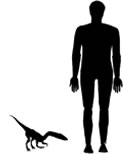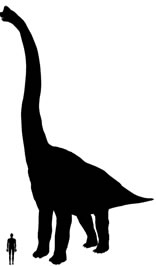You may also be intrested in: Free Dinosaur games
Dinosaurs: How big were the Dinosaurs
You may also be intrested in: Free Dinosaur games
The largest dinosaurs were over 100 feet (30 m) long and up to 50 feet (15 m) tall such as Argentinosaurus, Brachiosaurus, Seismosaurus and Supersaurus. Some of the smallest dinosaurs, such as Compsognathus and Microraptor were about the size of a chicken. Small dinosaurs fossils are harder to find and are weathered away easily however, of all the dinosaur fossils found, the smallest are about the size of a chicken. These Dinosaurs include: Pronounced: KOMP-SOW-NAY-thus Name Means: "Pretty Jaw"How big were the Dinosaurs?
Smallest Dinosaurs
Length: 2 - 3 feet 6 (0.7 m)
Height: 1 foot (0.3 m)
Weight: 8 pounds (3 kg)
Diet: Carnivore (Insects,
Lizards, Meat)
Time: Late Jurassic
Habitat: Tropical Lagoons
Fossils Found: Europe
The tallest of all the known Dinosaurs were the Brachiosaurid Sauropods. The Brachiosarids were gigantic herbivorous Dinosuars. Their most stricking feature, other than their shear size, was their long fore legs which were much longer than their hind legs. These sauropods are amongst the largest land animals known to have ever walked the Earth: The longest dinosaurs were the sauropods, in particular the diplodocid sauropods such as Supersaurus and titanosaurid sauropods such as Argentinosaurus. These Dinosaurs had very long necks which were counterbalanced by huge tails. Some of the largest sauropods included: Tallest Dinosaurs
Pronounced: BRACK-ee-oh-SAW-rus
Name Means: "Arm Lizard"
Length: 82 feet (25 m)
Height: 40 feet (12 m)
Weight: 60 tons (54,500 kg)
Diet: Herbivore (Plants)
Time: Middle to Late Jurassic - 150 million years ago
Habitat: Open Woodland
Fossils Found: Africa, Southern Europe, Northern, Western North America

Longest Dinosaurs
Dinosaur size FAQ
Q1: How big was the largest dinosaur?
A1: The largest dinosaur known is the Argentinosaurus, which could reach up to 100 feet (30 meters) in length and weigh around 100 tons.
Q2: How small was the smallest dinosaur?
A2: The smallest known dinosaur is the Microraptor, which was about the size of a crow, measuring around 2.5 feet (0.76 meters) in length.
Q3: How big was the Tyrannosaurus rex?
A3: Recent studies suggest that the largest T. rex could have been up to 50 feet (15 meters) long and weighed around 15 tons.
Q4: Did all dinosaurs grow to be very large?
A4: No, not all dinosaurs were huge. Some were as small as chickens, like the Compsognathus, which was about 3 feet (0.9 meters) long.
Q5: How do scientists estimate the size of dinosaurs?
A5: Scientists use fossilized bones and computer modeling to estimate the size of dinosaurs, factoring in variables like population size, growth rate, and the incompleteness of the fossil record.
Q6: Were there any dinosaurs bigger than the blue whale?
A6: While some dinosaurs were very large, the blue whale is still the largest animal to have ever lived, reaching lengths of up to 100 feet (30 meters) and weights of around 200 tons.
Q7: How big were dinosaur eggs?
A7: Dinosaur eggs varied in size, but the largest known eggs, from the dinosaur Hypselosaurus, were about the size of a football, around 1 foot (30 centimeters) long.
Q8: Did dinosaurs grow continuously throughout their lives?
A8: Dinosaurs, like modern reptiles, likely grew throughout their lives, but their growth rate slowed down significantly once they reached adulthood.
Q9: How do we know the size of dinosaurs if we only have their bones?
A9: By studying the bones and comparing them to modern animals, scientists can make educated guesses about the muscle mass and overall size of dinosaurs.
Q10: Are there still undiscovered giant dinosaurs?
A10: It’s possible! New discoveries are made regularly, and some scientists believe there could be even larger dinosaurs yet to be found.
You may also be intrested in:
Tags: How big were Dinosaurs, Dinosaurs size, tallest Dinosaurs, how tall are Dinosaurs, smallest Dinosaurs, biggest Dinosaur, Dinosaur facts

